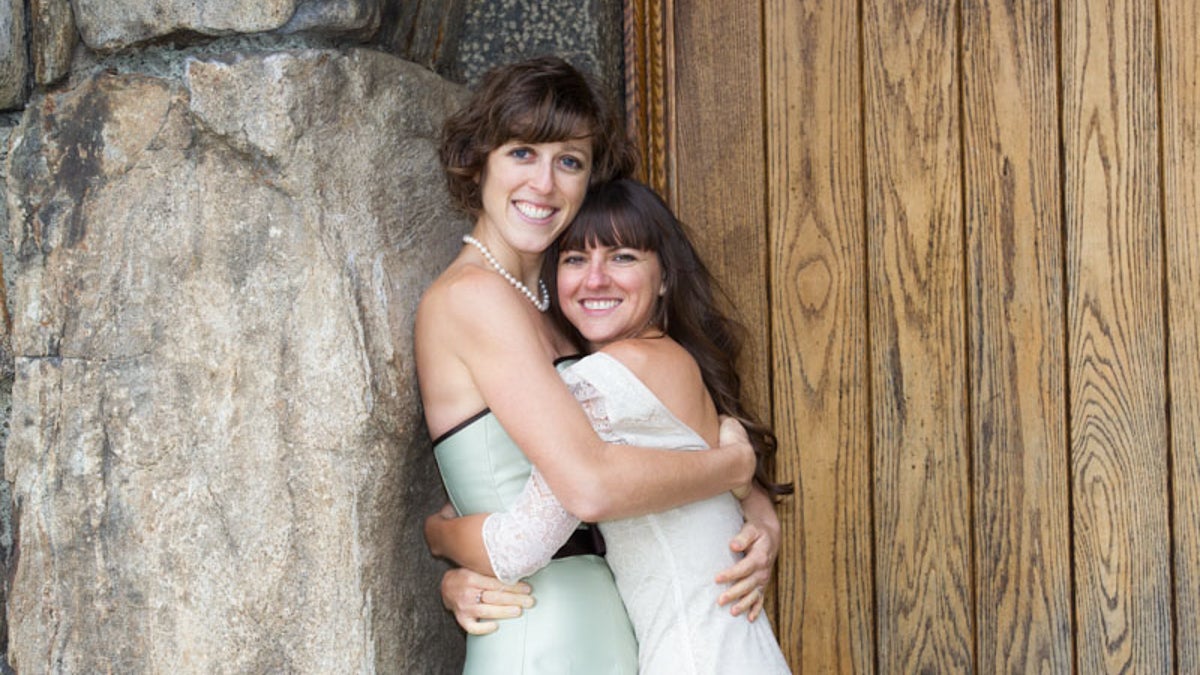The many options of choosing half of your future child’s genes
Listen
Megan Schneider (left) and Rachelle Schneider on their wedding day in 2013. (Photo by B. Proud)
The list for parents to choose from can include smarts, looks, college major.. even pet preferences and zodiac signs.
Rachelle Schneider and Megan Schneider of South Philadelphia were married in 2013, and they knew they wanted to have children.
At first, they thought about asking a male friend to be a donor, to help them conceive, but eventually, they decided to go with a sperm bank.
Once they signed up with a bank, they got full access to a massive catalogue of donors – and they were surprised how detailed the descriptions were – and how many options they would have to discuss.
“It was way more information than we ever would have expected or requested,” said Rachelle Schneider. “It’s fun, but it’s also really difficult.”
“You’ll get access to things like audio interviews, pictures when they were babies, a full family history,” said Megan Schneider. But, that’s not all. The catalogue also includes “SAT scores, what they majored in in school, what kind of profession they work in, all the way up to silly things like what is their sign, and what’s their favorite pet.”
Rachelle said looking through their options felt a bit like online dating. “You’re sizing these people up, and you get to choose. It’s like choosing your mate, which in a way it is.”
They wanted to be deliberate and intentional with every step of this process. Both had genetic testing done before getting started, and reviewed their family health history.
“Rachelle’s family has some instances of cancer, I have some Alzheimer’s in my family,” said Megan. “So, we avoided donors who had that in their family history.”
But, looks also played a role.
“I am very short, Megan is very tall,” said Rachelle. “So height was a factor. Height, brains and some kind of look that meshed with both of us.”
The ideal candidate had to have a good nose said Megan. “We both have prominent noses, so we wanted a strong nose.”
The Schneiders selected from a group of donors with “ID option,” where future children can contact the donor when they’re 18.
But during the selection process, Rachelle and Megan couldn’t see the donors’ names, ages, or where they live.
“You’re still removed from them,” said Megan, who added that she prefers that. “If I knew them in real life, I could probably find reasons why I wouldn’t want to choose that person.”
Rachelle said it was difficult not to get caught up in looks – especially when browsing through cute baby photos of potential donors. They admitted to ruling out a few candidates for being too hairy in later photos – but mostly tried to focus on other qualities.
“One of the things we were drawn to was their reason for donating. That could tell a lot about that person,” said Rachelle. They read the donors’ essays and listened to the audio interviews. One donor said “I have really good genes, I should pass them on.” The Schneiders passed on him.
Both said they were drawn to donors who said their reasons for donating were altruistic – that they wanted to help families who were struggling with infertility, or couldn’t conceive a child.
And, they focused on how seriously the donor seemed to take the process – the essay and the audio interview.
“We will probably share this information with a child one day,” said Megan. “And we want them to hear somebody who put thought into it.”
WHYY is your source for fact-based, in-depth journalism and information. As a nonprofit organization, we rely on financial support from readers like you. Please give today.




